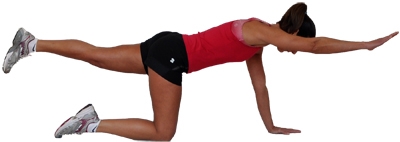
There’s a question I get asked a lot when recommending core strengthening to my low back pain patients: “Why are you telling me to work on my core, when it’s my back that hurts?” More often than not, people expect to be given exercises that strengthen the back directly because that’s where their pain is. So why is working on the “front” important and how does it help to prevent future episodes of low back pain?
When we talk about back pain, we have to talk about spinal stability. Before pain happens, there is often a dysfunctional movement pattern present and the result is instability, which leads to pain. For the spine to function efficiently, it needs to be able to bear loads – but it also needs to be flexible enough to allow movement, while remaining secure enough to avoid pain and injury. The repetition of our daily activities and sedentary nature of many of our jobs can interrupt this delicate balance and the result is instability. In order to prevent this, we need to ensure that the muscles surrounding the spine are coordinated and follow a proper pattern of contraction (e.g. abdominal and extensor muscle groups).
Spinal stability and motor control become compromised if muscles are activated improperly. When certain muscle groups aren’t functioning properly, the result is that the surrounding structures have to work harder and take on more of the stress/load and this often results in pain.
The solution? We need to re-activate certain muscles so we can restore proper patterns of movement. Don’t worry, it’s not as painful as it sounds! The key here is not to use just any assortment of core exercises – because with some exercises, we end up adding more compressive load to our spines and can end up making our low back pain worse. It’s important to choose exercises that involve a neutral spine. Here are my favourites:
Exercise 1: The Plank
For core strength and stability. When you’ve mastered this one, you can even add alternating leg raises. But don’t let your pelvis shift or sag in the middle… that’s cheating!
Exercise 2: Side Bridge
Used to train the lateral musculature. When you get to be a real pro, try going from the forward plank directly into the side plank!
Exercise 3: The Bird Dog
Used to train and improve endurance of the low back muscles.
Exercise 4: The Crunch
To improve abdominal strength. This is NOT a sit-up! If it helps, think of it as a “sternal crunch.” The chin stays tucked while the spine is straight and shoulders are raised slightly off the floor. (For more on traditional sit-ups and why they aren’t recommended for those with low back pain, go to:http://www2.macleans.ca/2010/01/19/the-man-who-wants-to-kill-crunches/).
Exercise 5: Dead Bug.
When you’ve mastered the crunch, it’s time to try out the dead bug. Look out lower abs!
McGill, S. Designing Back Exercise: from Rehabilitation to Enhancing Performance. 2010: 1-12.




